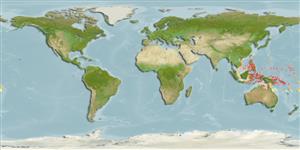Environment / Climate / Range
Ecology
Marine; reef-associated; non-migratory; depth range 10 - 30 m (Ref. 90102). Tropical, preferred ?
Western Pacific: Indonesia to Papua New Guinea and Bismarck Archipelago. Reported from the Philippines (Ref. 9710).
Size / Weight / Age
Maturity: Lm ? range ? - ? cm
Max length : 15.0 cm TL male/unsexed; (Ref. 4859)
An extremely wary fish found in sheltered lagoons or exposed outer reefs; to a depth greater than 30 m (Ref. 9710). More common along drop-offs in the vicinity of sponges on which they feed (Ref. 9710). Oviparous (Ref. 205). Form pairs during breeding (Ref. 205).
Life cycle and mating behavior
Maturity | Reproduction | Spawning | Eggs | Fecundity | Larvae
Form pairs during breeding (Ref. 205).
Burgess, W.E., 1978. Butterflyfishes of the world. A monograph of the Family Chaetodontidae. T.F.H. Publications, Neptune City, New Jersey. (Ref. 4855)
IUCN Red List Status (Ref. 115185)
CITES (Ref. 94142)
Not Evaluated
Threat to humans
Harmless
Human uses
Aquarium: commercial
More information
ReferencesAquacultureAquaculture profileStrainsGeneticsAllele frequenciesHeritabilityDiseasesProcessingMass conversion
Tools
Special reports
Download XML
Internet sources
Estimates of some properties based on models
Phylogenetic diversity index (Ref.
82805): PD
50 = 0.6250 [Uniqueness, from 0.5 = low to 2.0 = high].
Bayesian length-weight: a=0.02188 (0.01072 - 0.04464), b=3.02 (2.85 - 3.19), in cm Total Length, based on LWR estimates for this (Sub)family-body shape (Ref.
93245).
Trophic Level (Ref.
69278): 2.8 ±0.2 se; Based on size and trophs of closest relatives
Resilience (Ref.
69278): High, minimum population doubling time less than 15 months (Preliminary K or Fecundity.).
Vulnerability (Ref.
59153): Low vulnerability (12 of 100) .
